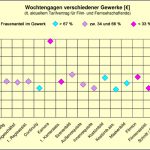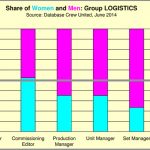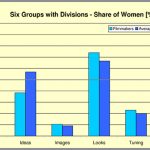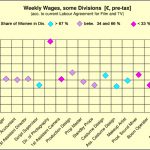English Version follows German.
Gibt es das wirklich, Frauengewerke, Männergewerke?
Heute geht es um 32 Teampositionen am Filmset und 2 Positionen vor der Kamera. Anhand der Datenbankeinträge von Crew United werden Frauen– und Männeranteile in den unterschiedlichen Bereichen einer Filmproduktion ausgewertet (8 Grafiken in einer Bildergalerie am Ende des Textes).
Crew United
Crew united entstand 1996 und wurde 5 Jahre später als crew united, Lutz und Zenglein GbR gegründet, mit dem Ziel, „eine Internetplattform zu schaffen, die Freelancern ermöglicht, sich und Ihre Qualifikationen darzustellen und so potentielle Arbeitgeber auf sich aufmerksam zu machen.“ Daneben bietet Crew United aber auch eine umfassende Datenbank für Film- und Fernsehproduktionen mit deutscher Beteiligung, in deutscher und englischer Sprache. Das Logo – Kopf mit Käppi und Hand mit Megaphon – entwickelte der Illustrator und Grafiker Robert Oschließ 1997. Zum Relaunch 2003 wurde es von Jana Cerno komplett überarbeitet.
Das Logo – Kopf mit Käppi und Hand mit Megaphon – entwickelte der Illustrator und Grafiker Robert Oschließ 1997. Zum Relaunch 2003 wurde es von Jana Cerno komplett überarbeitet.
Auf Crew United-Einträge greife ich oft zurück, wenn ich Film- und Fernsehproduktionen vor und hinter der Kamera auswerte, da dort fast alle aktuellen Projekte aufgenommen sind. Ein Nachteil: die Dateneinträge beruhen auf Freiwilligkeit, was zur Folge hat, dass Stab- und Besetzungslisten unterschiedlich ausführlich erfasst sind. Auch die
Kategorisierung in Haupt-, Neben- und Tagesrollen ist relativ zufällig, da dies die Schauspieler/innen (auch) selber eintragen können und Produktionsfirmen es unterschiedlich handhaben. Als Beispiel die TATORTtreihe: manche Filme klassifizieren neben dem Ermittlungsteam 6 und mehr weitere Hauptrollen, andere nur eine, und die übrigen Schauspieler/innen dann in Nebenrollen. Aber das ist ein anderes Thema.
Die Teampositionen werden in der Datenbank stark differenziert:
 Ich habe wie gesagt 34 Positionen ausgewertet, deren Daten mir Vincent Lutz und Martin Völker von Crew United zusammengestellt haben, herzlichen Dank! Der Übersichtlichkeit halber sind die Positionen in sechs Gruppen untergeteilt, wobei die Reihenfolge an eine typische Stabliste anlehnt. Die Einteilung sowie die Gruppentitel könnten natürlich auch anders aussehen, für Vorschläge bin ich jederzeit offen:
Ich habe wie gesagt 34 Positionen ausgewertet, deren Daten mir Vincent Lutz und Martin Völker von Crew United zusammengestellt haben, herzlichen Dank! Der Übersichtlichkeit halber sind die Positionen in sechs Gruppen untergeteilt, wobei die Reihenfolge an eine typische Stabliste anlehnt. Die Einteilung sowie die Gruppentitel könnten natürlich auch anders aussehen, für Vorschläge bin ich jederzeit offen: Datengrundlage
Datengrundlage
Diese ausführlichere Untersuchung – in der Vergangenheit hatte ich maximal einen 11-Gewerke-Check vorgenommen (Kunst oder Kommerz, wo arbeiten die Filmfrauen?) – berücksichigt zum einen mehr Gewerke, insbesondere in den Gruppen LOGISTIK und BILD, zum anderen sind einzelne Berufe um Assistenzpositionen erweitert.
Bei den Filmschaffenden in der Crew United Datenbank wird nicht unterschieden, ob Person A jährlich in zehn Produktionen mitarbeitet und Person B nur alle drei Jahre in einer, ob Person C seit 20 Jahren regelmäßig in großen Kinoproduktionen, Person D in Vorabendserien, und Person E erst in einem Hochschulfilm tätig war. Allerdings prüft das Team von Crew United sorgfältig, bevor ein Projekt in die Datenbank aufgenommen wird, so dass schwerpunktmäßig professionelle Film- und Fernsehproduktionen und deren Mitarbeiter/innen erfasst sind.
Soweit ich weiß werden Filmschaffende nach mehreren Jahren Untätigkeit (z.B. wegen altersbedingtem Ruhestand, Berufswechsel oder jahrelanger Arbeitslosigkeit) aus der Datenbank nicht entfernt, es kann also auf Dauer zu einer gewissen Überalterung der Statistik führen, und wenn der Nachwuchs sich gendermäßig anders zusammensetzt, wird sich das auch erst nach Jahren in der Statistik niederschlagen. In diesem Zusammenhang wäre es interessant, die aktuellen Crew United-Zahlen mit den Daten von vor 10 Jahren vergleichen zu können, aber das ist leider ncht möglich.
Korrektur! (18.7.14) Nach einem Kommentar von Oliver von Crew United (s.u.) und klärender Rücksprache möchte ich die letzten Punkte korrigieren. Richtig ist (Zitat Oliver):
In solchen Abfragen werden ausschließlich aktive Basic- und Premiummember berücksichtigt, also nur Member mit einem eigenen Profil, das vom Member selbst oder mindestens seiner Agentur verwaltet wird. Also nur solche, die in der Filterlisten Freelancer und Schauspieler/Sprecher gelistet werden.
Das heißt: von Dritten bei Filmprojekten eingetragene Regisseure und Kamerafrauen, Schauspielerinnen und Kostümbildner usw. ohne eigenes Crew United Profil werden in den Statistiken nicht berücksichtigt.
Abbildungen
Für jede Gruppe werden die Frauen- und Männeranteile der einzelnen Positionen prozentual dargestellt. Eine siebte Abbildung zeigt den Frauenanteil aller Filmschaffender und den Frauenanteilmittelwert der Gewerke in den jeweiligen Gruppen. Und die letzte Abbildung zeigt die dazugehörigen Gagen, genauer gesagt die in der aktuellen Fassung des Tarifvertrags für auf Produktionsdauer beschäftigte Film- und Fernsehschaffende aufgeführten Wochengagen. Nur die Häfte der untersuchten Teampositionen sind darin tariflich geregelt.
Auswertung
Insgesamt sind 9.437 weibliche und 12.729 männliche Filmschaffende in allen 34 Positionen erfasst. Die Schauspielerinnen und Stuntfrauen (Gruppe SPIEL) stellen 54,4 % aller weiblichen Filmschaffenden, Schauspielerin ist also der vorherrschende FIlmberuf für Frauen. Schauspieler und Stuntmänner hingegen machen nur 38,7 % aller männlicher Filmschaffenden aus, sind aber immer noch die stärkste Position.
Im Folgenden einige Anmerkungen zu den einzelnen Gruppenauswertungen (Grafiken siehe Galerie).
Gruppe LOGISTIK
Den höchsten Frauenanteil weist die Filmgeschäftsführung auf (61,4 %), den niedrigsten die Set-Aufnahmeleitung (23,4 %).
Redakteur/innen, die wie es heißt zunehmend an Entscheidungskompetenz gewinnen in Bezug auf Filmstoffe, Rollen und Besetzungen, sind gendermäßig relativ ausgeglichen. Neben den Produzent/innen (73,9 %) weisen vor allem die logistischen Teampositionen am Set hohe Männeranteile auf (zwischen 64,8 und 76,6 %). Der mittlere Frauenanteil aller Filmschaffenden in dieser Gruppe liegt bei 34,9 %, der Mittelwert der 6 Positionen bei 39,1 %.
Gruppe IDEE
Es heißt, dass an den Filmhochschulen im Fach Regie gleich viele Frauen und Männer ihren Abschluss machen, und dass weniger Regisseurinnen als Regisseure ihren 2. Langfilm drehen. Belastbare Zahlen habe ich zu beiden Aussagen allerdings bisher noch nicht gefunden. Der Regisseurinnenanteil bei Crew United – d.h. in der Gesamtheit aller erfassten Regiepositionen der letzten 15 Jahre – liegt bei 23,2 %, also einem knappen Viertel.
Interessant sind die Werte für Erste (48,9 %) und Zweite Regieassistenz (65,4 %), die deutlich höhere Frauenanteile aufweisen. Warum arbeiten auf diesen eher ausführenden, weniger kreativen, weniger inszenierenden Positionen so viel mehr Frauen? Reicht es ihnen, zweite oder dritte Geige zu spielen? Lässt sich diese Arbeit leichter mit ihrem übrigen (vielleicht Familien-)Leben vereinbaren? Scheuen Frauen eher die volle Verantwortung? Oder finden Regisseurinnen schlicht seltener Arbeit? (siehe den Regisseurinnenanteil von unter 10 % bei den TATORTEN (Tatorte 2013, ein Rückblick) und den 2013er ZDF Fernsehfilmen der Woche).
Oder ist das nur eine Momentaufnahme, und die vielen Regieassistentinnen arbeiten sich langsam hoch und wollen nach einigen Jahren Assistenz ins Regiefach wechseln? Wobei mir zwei Regisseurinnen sagten, dass heute der Weg über die Regieassistenz eher unüblich und nicht zu empfehlen ist.
Die Positionen Casting (laut Casterin Anja Dihrberg eine „dienende Tätigkeit“) und Continuity weisen Frauenanteile zwischen 80 und 90 % auf. Bei einem derartigen Übergewicht eines Geschlechts stellt sich die Frage, warum diese Tätigkeiten für das andere Geschlecht so unattraktiv sind.
An dieser Stelle möchte ich den BIENENOPARAMETER einführen. Dieser berücksichtigt die Größen Macht, Geld und Liebe als Motivation für eine Handlung oder in diesem Fall für eine Tätigkeit. Bienenparameter = (Macht + Geld) x 2 + Liebe, wobei die Werte für Macht, Geld und Liebe zwischen 1 und 10 liegen. (Damit es hier nicht zu lang wird: demnächst gibt es eine ausführlichere Beschreibung unter Methode.)
Zurück zu den Caster/innen: Wie viel Macht haben sie? Hm. Sie haben einen gewissen Gestaltungsspielraum, aber der wird – wie es gerüchteweise heißt, beispielsweise durch Vorgaben der bereits genannten Redakteur/innen – immer mehr eingeschränkt. Ein Caster (sic) erzählte mir, dass er nach mehreren Jahrzehnten als Caster mit fiktionalen Formate aufgehört hat und jetzt nur noch für die Werbebranche arbeitet, da er dort mehr kreative Freiräume hätte und er im Film- TV-Bereich einerseits zu viele Besetzungsvorgaben bekommen und andererseits zu konservativ arbeiten musste („Wenn schon nicht die üblichen Verdächtigen, so sollte ich zumindest immer die üblichen Typen besetzen“). Wie sieht es mit dem Geld aus? Ein anderer Caster (sic) erzählte mir, dass er trotz vollem Auftragsbuch immer weniger verdient. Eine klassische Castingarbeit, inklusive gründlich durchgeführter Castings ist überhaupt nicht mehr realisierbar. Und Liebe, d.h. Anerkennung? Fragt mal 10 (oder von mir aus 100) Leute in Eurem Bekanntenkreis nach ihren 10 deutschen Lieblingsfilmen. Lasst sie die männlichen und die weiblichen Hauptrollen nennen, die Regie, die Drehbuchautor/innen und die Caster/innen. Kennt irgendjemand außerhalb der Filmbranche auch nur einen Namen beim Casting? Die Branche und natürlich auch der Bundesverband Casting BVC unternimmt einiges, z.B. wird immer wieder gefordert, Casting im Vorspann eines Films und nicht erst, wenn überhaupt, spät im Abspann zu nennen, der im TV ja oft schon gar nicht mehr gezeigt wird, es gibt Castingpreise und mehr. Aber ich würde sagen, dass Casting insgesamt einen relativ niedrigen Bienen-Parameter hat, und deshalb vielleicht für Männer keine so attraktive Tätigkeit ist.
Gruppe BILD
Die Gruppe mit den meisten Männern. 89,6 % Männeranteil in der Gruppe, im Schnitt der 8 Positionen 91 %.
Der Anteil der Kamerafrauen beträgt nur 10 %, allerdings sind die Werte für die Erste und Zweite Kameraassistenz höher (16,2 bzw. 29,6 %). Was bedeutet das? Wächst da der weibliche Nachwuchs heran (vorausgesetzt, dass die Kameralaufbahn über die Assistenzpositionen geht)? Auch hier könnten natürlich die Angaben der Filmschulen aufschlussreich sein.
Eine noch deutlichere Männerdomäne als die Kamera ist das Licht. Der Männeranteil bei Oberbeleuchtung ist 97,5 %. Warum? Weil Scheinwerfer so schwer sind? Oder weil es immer so war? Der Name Best Boy (für Lichtssistenz) spricht da ja Bände. Interessiert Frauen Licht nicht, oder können Männer besser sehen? Gibt es einen Zusammenhang zur (Nicht-)Förderung von Jungen und Mädchen in MINT-Fächern (= Mathematik, Informatik, Naturwissenschaften, Technik)?
Gruppe LOOK
Dies ist die Gruppe mit dem höchsten Frauenanteil. Auf die 7 Positionen bezogen ist der Mittelwert 66,6 %, und für alle Filmschaffenden in dieser Gruppe insgesamt sogar 74 %, das sind fast 3/4. Der Frauenanteil in den Gewerken Kostüm und Maske liegt über 90 %, was umgekehrt einen Männeranteil von weniger als 10 % bedeutet. Eine Maskenbildnerin erzählte mir, dass in den 1950er Jahren das Maskenbild beim Film eine Männerdomäne war. Warum ist es heute so anders? Kleine Jungen und Mädchen mögen es, sich zu verkleiden und zu schminken und auch bei den Abimottowochen machen junge Männer und Frauen gleichermaßen mit. Trotzdem, Männer und Kostümbild, das scheint in der Filmbranche nicht wirklich stattzufinden. Warum? Weil Kleider und Make-Up als Mädchen- bzw. Frauenthema gelten? (keine ,Frauenzeitschrift’ ohne Schminktipps und endlose Modeseiten). Oder wegen der niedrigeren Bezahlung, die es auch in den Ausbildungsberufen um Frisieren, Make-Up und Schneiderei gibt? Die große Kostümbildnerin Ingrid Zoré, die aktuell im Präsidium der Bundesvereinigung der Filmschaffenden-Verbände sitzt, hat diesen Männermangel mehrfach öffentlich beklagt. Können beispielsweise Projektwochen in Schulen helfen, diese Geschlechterstereotype in der Filmbranche „Mann filmt, Frau kleidet ein“ aufzuweichen? Aber das ist ein anderes Thema.
Gruppe TUNING
Die zweitmännlichste Gruppe. Einzig der Schnitt fällt etwas heraus, Ton und Komposition sind absolute Männerdomänen (jeweils ca. 95 %). Warum? Ich habe noch von keiner Untersuchung gehört, die Frauen ein schlechteres Gehör oder eine schlechtere Feinmotorik (die Regler!) attestiert. Also was dann? Eine Frage der Erziehung? Technikantipathie? Eine Cutterin erzählte mir, dass der Männeranteil im Editing seit der Digitalisierung deutlich zugenommen hat. Im Zuge von meiner Arbeit als Sprecherin (Hörspiele, Synchron usw.) habe ich immer wieder auch mit Frauen in den Aufnahmestudios gearbeitet. Was macht die Filmtontechnik so anders, dass sie Frauen nicht (mehr) interessiert bzw. sie dort nicht einsteigen / wollen?
Gruppe SPIEL
Das Geschlechterverhältnis im Schauspiel ist relativ ausgeglichen (51,4 % Frauen), was zeigt, dass die Berufswahl nicht parallel zu den tatsächlichen Arbeitsmöglichkeiten verläuft, wie mehrfach in diesem Blog ermittelt gibt es deutlich mehr männliche als weibliche Rollen in Film und Fernsehen.
Der Frauenanteil unter den Stuntleuten ist weniger als ein Viertel (21,2 %). Stuntleute kommen zum Einsatz, wenn es um Schlägereien, Explosionen oder über Autos springen geht, aber auch bei Reitszenen, Auto- und Motorradfahrten, bei Stürzen, bei Szenen auf hohen Gebäuden oder am Abgrund, beim Tauchen, Balancieren, Erschossen werden u.a.m. Solche Szenen gibt es anscheinend seltener für weibliche Rollen, die eher beim Wellness als beim Klettern gezeigt werden ((wobei in Deutschland ja auch nicht gerade viele Actionfilme mit männlichen Hauptfiguren gedreht werden.). Ist dies ein weiteres Indiz für eine brave Randstellung von Frauen im deutschen Film und Fernsehen? Übrigens erzählte mir eine Mitarbeiterin vom Verband der Stuntleute, dass es in ihrem Beruf gleiche Bezahlung für Frauen und Männer gibt. Im Schauspiel ist das noch lange nicht erreicht, aber das ist ein völlig anderes Thema.
GAGEN
Die Tarifgagen sind nur eine Orientierung, da es zum einen möglich ist, höhere Gagen auszuhandeln, und es zum anderen auch hinter der Kamera zu diesen immer verbreiteteren Sondergagen sprich: niedrigeren Gagen kommt. Der Statusbericht 2013, die Auswertung einer Umfrage zur Arbeitssituation der einzelnen Gewerke bei Film und Fernsehen wurde von der Bundesvereinigung der Filmschaffenden-Verbände Die Filmschaffenden in Auftrag gegeben und kann über ihre Webseite abgerufen werden. Hier wurde ermittelt, dass ein Drittel von 70 % der Verträgen untertariflich waren. Wie bereits an anderer Stelle erwähnt (Kino, Kinder, Karriere) wurde leider versäumt, das Geschlecht der Umfrageteilnehmenden zu erheben, so gibt es keine Angaben zur unterschiedlichen Bezahlung von weiblichen und männlichen Teammitgliedern, über die inoffiziell immer wieder berichtet wird. Sind das Einzelfälle?
Aber auch sonst lässt sich feststellen: männerdominierte Teampositionen sind besser bezahlt als frauendominierte. Der Wochengagenunterschied zwischen Kamera und Kostüm beträgt 1271 Euro, d.h. Kameraleute verdienen fast das Doppelte, und auch bei den jeweiligen Assitenzen gibt es noch einen Unterschied von 266 € in den Tarifwochengagen.
Warum? Ist die Kamera für den Film doppelt so wichtig wie das Kostüm und der Ton wichtiger als die Maske?
Oder ist es der ewige Missstand, dass typische Frauenlehrberufe einfach schlechter bezahlt werden als typische Männerlehrberufe, – natürlich ohne weniger anspruchsvoll in Ausbildung, abverlangten Kenntnissen und Fähigkeiten zu sein. Siehe Frisierberuf und Klempnerei, Schneider/in und Elektriker/in usw. Woran liegt das? Weil Frauen genügsamer sind, keine Lobby haben? Weil Männer für so wenig Geld nicht arbeiten wollen oder sollten? Weil immer noch von dem – längst überholten – gesellschaftlichen Modell ausgegangen wird, dass es einen (!) Haupternährer geben wird für eine Familie, für eine Ehe, die ein Leben lang hält?
Das waren sehr viele Fragen, auf die es noch keine verlässlichen Antworten gibt.
Und jetzt die Abbildungen:
- 1.839 Filmschaffende. 35 % Frauen.
- 2.593 Filmschaffende. 38 % Frauen.
- 3.191 Filmschaffende. 10 % Frauen.
- 2.557 Filmschaffende. 74 % Frauen.
- 1.919 Filmschaffende. 23 % Frauen.
- 10.067 Filmschaffende. 51 % Frauen.
- Frauenanteil innerhalb einer Gruppe vs. Mittelwert der Frauenanteile aller Gewerke in einer Gruppe. Je weiter die beiden Säulen auseinander gehen, umso heterogener ist die Gruppe.
Filmcrafts: Some with Women, Some with Men?
Today’s focus is on 32 team positions on film sets and 2 positions in front of the camera. Using data from the database of crew united, the shares of women and men for different divisions of film productions are analyzed. (Gallery with figures at the end of the text).
Crew United
Crew united was founded in 1996 and was established as crew united, Lutz and Zenglein BGB company 5 years later, with the aim of “creating an online platform that would enable freelance film people to present themselves and their qualifications and thus attract the attention of possible employers”. Furthermore crew united offers a very comprehensive data base of film and TV productions with German participation. The logo – a head with a cap and a hand with a megaphone – was created by illustrator and designer Robert Oschließ in 1997 . For the relaunch in 2003 the logo was done over by Jana Cerno.
The logo – a head with a cap and a hand with a megaphone – was created by illustrator and designer Robert Oschließ in 1997 . For the relaunch in 2003 the logo was done over by Jana Cerno.
I quite regularly use the crew united data base when I am evaluating the people working film and TV productions behind and in front of the camera, since it contains nearly all current productions. There is a slight disadvantage in the information being voluntary, so crew and cast lists will invariably be incomplete. Also the categorization in leading and supporting roles, and sometimes in day roles, is quite coincidental, since the actresses and actors very often do the classification themselves, and also production companies deal with it in different ways. As an example we can once again look at the TATORT films (the leading 90 min. cop and crime films on German TV): Some films will show 6 leading characters outside the main investigatory team, others only 1, classifiying the rest as supporting cast. But that is a topic for another day.
The team positions certainly are listed in a very differenciated manner on crew united:
 As I said I am only analysing 34 positions the data for which has been supplied by Vincent Lutz and Martin Völker of crew united, thank you very much!
As I said I am only analysing 34 positions the data for which has been supplied by Vincent Lutz and Martin Völker of crew united, thank you very much!
The positions are broken down into six groups, the order is loosely that of a typical crew list. Of course the groups could have been arranged in a different way and given different name, as always I am open for suggestions: Data Base
Data Base
Today’s more detailed research – in the past I investigated 11 divisions at most (“Give me Art, Give me Money” Female Filmmakers Part 1: Behind the Camera) includes more crew divisions, especially in the groups LOGISTICS and IMAGE, also some assistant crew positions have been added.
The crew united database does not differenciate if e.g. filmmaker A participates in 10 productions per year and filmmaker B only in one in three years, if filmmakers C has been working regularly in big feature films for twenty years, filmmaker D only in late afternoon TV series, and filmmaker E only completed work in one film school production. However the team of crew united does check all projects thoroughly that are entered in the database, so that we can assume that very mostly professional film and TV productions and their staff are recorded.
As far as I know filmmakers are not removed from the database after multiple inactive years caused by retirement, career changes or long lasting unemployment, so in the long run statistics may age a little, and if the newcomers have different gender ratios it would probably take years to show in the figures. It would be interesting to compare the current crew united data with that of 10 years ago, but unfortunately this is not possible.
Correction! (July 18, 2014). Following a comment by Oliver of Crew United (see below) and some clarifying emails I would like to correct the last paragraphs. To quote Oliver the facts are:
In requests such as yours we only include active basic and premium members, i.e. only members with a profile in the database, that is managed by the member or his / her agency. So you only get freelancers and actors/actresses and speakers that are included in our filter lists.
To clarify: if a third party e.g. a production company or filmmaker adds a director to a film project, or a camera person, an actor / actress or a costume designer who doesn’t have a profile on crew united, they will not be included in the statistics.
Figures
For each of the six groups a diagram depicts the percentaged shares of women and men. A seventh graph shows the share of women for all filmmakers and the average female percentage for the departments in the given groups. The last figure in the gallery adds some examples of weekly wages, taken from the current Labour Agreement for Film and TV. Only half the investigated team positions are covered by it.
Analysis
A total of 9.437 female and 12.729 male filmmakers in 34 positions are covered. The actresses and stuntwomen (Group ACTS) provide 54,4 % of all female film makers, acting is the dominant film job for women. Actors and stuntmen only provide 38,7 % of all male film makers, but they are also the predominant position for all film men. Overall the departments are mixed differently genderwise, for a variety of reasons, which would be interesting to look into at some point.
Here are some comments on each group. All figures can be found in a gallery at the end of today’s text.
Group LOGISTICS
The highest share of women in this group is that of the production accountants (61,4 %), the lowest for the set managers (23,4 %).
Commissioning Editors who are said to gain more and more decisive powers as far as film plots, roles and casts go, are quite gender balanced. Next to the producers (73,9 %) it is mainly the logistic set positions that are male dominated (between 64,9 and 76,6 %). The average share of women for all filmmakers in this group is 34,9 %, the average for all 6 positions is 39,1 %.
Group IDEAS
I have heard that it’s roughly the same number of women and men that finish film schools in the directing classes, and that less female than male directors shoot a second feature film after school. But I have found no reliable data for this so far. The share of women for directing in the crew united data base – i.e. in all productions of the last 15 years – is 23,2 %, that is nearly a quarter. Interestingly the values for 1st (48,9 %) and 2nd Assistant director (65,4 %) are distinctly higher.
So why are there relatively more women working in these more executive, less creative, less directing positiions? Are they happy enough playing second or third fiddle? Is it easier to combine this sort of work with their (family) life? Are women afraid of taking full responsibility? Or do female directors simply find work less easily than men? (The statistics for the top crime and cop TV movies TATORTE and the ZDF TV Movies of the Week for 2013 would suggest this, with the shares of female directors below 10 %).
Or is this just a momentary snap-shot, and the assistant directors want to slowly work their way up to the top and become directors eventually? I don’t know. I was only told by two directors that nowadays a career via assistant directing is highly unusual and not really recommendable.
Now looking at the Casting Directors (according to casting director Anja Dihrberg a “serving function”) and Script Supervisors we find female shares between 80 and 90 %. With such a majority it makes sense to ask if and why these functions are so unattractive to the opposite sex. In order to maybe find an answer I would like to introduce the BEE PARAMETER. It considers the factors Power, Money and Love as motivators for an action, or in this case a job choice. Bee Parameter = (Power + Money) x 2 + Love, with the values for power, money and love between 1 and 10. (I don’t want to let this article get tool long, so I will write about the Bee Parameter shortly in the Method section.
Back to the casting directors. How much Power do they have? Well. They have sort of a creative leeway, which is getting smaller and smaller for various reasons. One of them being demands by commissioning editors, who for example tend to ,suggest’ specific (popular) actresses and actors for the leading roles. A male casting director told me that after decades in his job he stopped casting fictional films and now only does castings for commercials since he can work more creatively there, with less restrictive demands, and also that casting for commercials is less conservative (“If they did want specific acting people, they certainly would ask for the conventional types”). Next, how about Money? Another male casting director told me that despite working overtime for years now he would earn less every year. Working in the original way, and this would include auditioning thoroughly for the leads and the main supporting parts, is not possible any more. And finally, how about Love, which would be appreciation and recognition of the work? Go and ask 10 (or even 100) of your friends and aquaintances about their 10 favourite films from your country. Ask them to name the leading actor and actress, the director, the script writer – and the casting director. Is there anybody outside the film industry who would know a single casting director by name?
German casting directors and also their association (BVC) do a lot of lobbying, among other things repeating their demand that Casting Directors should be namend in the opening titles of a film and not only – if at all – late in the closing titles that are not always shown on TV, prizes for casting directors have been established and so forth. But I would guess that the Bee Parameter for Casting is not a very high one and maybe this is a reason why this line of film work is not so attractive to men.
Group IMAGES
This group is the one with the highest proportion of male filmmakers. An overall share of 89,6 % for the whole group, and an average for the 8 positions of 91 %.
The share of camerawomen is 10 %, however the statistics for 1st and 2nd Assistant Camera are higher (16,2 and 29,6 %). Is this an indication of growing female participation? Assuming of course that the career path runs this way. Also in this department it would be interesting to have a look at the graduation numbers from film schools for camera and photography.
An even more strongly male dominated position is the light department, 97,5 % of the gaffers in the data base are men. Why? Because spotlights and other equipment weigh so heavily? Or because this has always been a men’s department? Just think about the term best boy. Are women not interested in light or is the men’s sense of vision higher developed?
Group LOOKS
And this is the group with the highest proportion of female filmmakers. All 7 positions considered the average is 66,6 %, and the female ratio of all individuals in this group is even higher, 74 %, nearly 3/4. Looking at costume and make-up we find even higher figures, both have more than 90 % women, which of course means that less than 10 % men work in these departments. The other day a female make up artist told me that in the 1950s the majority of make up artists in Germany were male. Why has this changed? Both boys and girls enjoy dressing up and disguising themselves for carneval parties etc., and they still do when they are 18 and have their “Abimottowochen”. (this is something that happens at a lot of schools, at least in the north of Germany: in the last term at school, before or after the final exams there is a week where every day has a different motto according to which the pupils come to school dressed up, disguised, in costume. Abi is short for Abitur, which are the final exams, similar to but different from A-levels)
Anyway, men and costume design, this does not seem to happen in the contemporary film industry. Why? Because clothes and make-up is something for girls and women only? (You will hardly find a German so-called ,women’s magazine’ without beauty / make-up tipps and loads of fashion pages.) Or does it have to do with the lower pay that trainees in jobs like hairdressing, make-up and dressmaking / tailoring get? The great costume designer Ingrid Zoré, who is currently chairmember of the Association of the Filmmakers’ Associations (Bundesvereinigung der Filmschaffenden-Verbände), has repeatedly deplored the lack of men in costume design. Maybe projects in schools could help reduce these gender stereotypes of men handling the camera and women the costumes? But this is a topic for another day.
Group TUNING
The group with the second highest male ratios. Only the editing is the odd one out, whereas sound and music are very male dominated departments (each around 95 %). Again: why? I have not heard from any survey that proved women to be worse at hearing or fine motor skills (the switches!). So what else could be behind this? A question of education? Some dislike for technical work? A female editor told me that the share of women in that line of work had increased considerably since film (and editing) turned digital. When working in a studio doing dubbing or voice-overs I have regularly worked with women. What is so different in the sound recording divisions of filmmaking that women are uninterested or can’t get in?
Group ACTS
As has been mentioned in this blog quite a few times the numbers of actresses and actors is pretty even (51 % women). At the same time this in no indicator for the ratio in the roles available in film and television, but that is another topic. What is interesting is looking at stuntpeople in the German industry. Even less than a quarter are female (21,2 %). And from that we can learn quite a lot about the character of roles. Stuntpeople not only come into the picture when the characters are fighting physically, or when there are explosions or people jumping over cars. Also they are needed when horse-riding, driving cars or motorbikes, standing on high buildings or at the edge of a cliff, diving, balancing, being shot, collapsing or stumbling heavily are part of the script. But apparently these actions are not written very often for female characters, that we see more frequently relaxing in a spa than rock climbing (but actually there aren’t many action films with male protagonists being shot in Germany either). Can we assume that the low number of stuntwomen is another indicator for the well-behaved, backgroundish position of female characters?
Wages
The weekly wages listed here are only an orientation of course, since it is possible for film makers to negociate higher pay, and also because it is not uncommon practice to get hired for „special“ i.e. lower wages, even in productions for public television. The Federal Association of Filmmakers‘ Organizations (Bundesvereinigung der Filmschaffenden-Verbände) published their Survey 2013 earlier this year (only available in German, download it here: Statusbericht). The participants stated that a third of the majority of contracts had been with conditions below those of the labour agreement.
As I already mentioned in another context (Cinema, Career, Children?) unfortunately the questionnaire did not ask for the participants‘ gender, so there is no information on any unequal pay situations for female and male filmmakers which apparently do occur in various divisions of film making at times.
But one thing becomes apparent: the strongly male dominated departments get better pay than the strongly female dominated ones. The difference in weekly wage between camera /DOP and costume designer are 1.271 €, so camerapeople get paid nearly twice as much, and looking at the respective assistants there is still a difference of 266 €. Why? Because camera is twice as important as the costume, and sound is more important than make-up?
Or is this the common nuisance, that typical apprentice jobs for women get less pay than typical apprentice jobs for men – while at the same time of course not being any less challenging as regards the training, the required knowledge and skills. (e.g. hairdressing and plumbing, tailoring and electricianing etc.) Why is this so? Because women are more frugal, or because they don’t have a lobby? Because men should not or would not work for little money? Because at the basis of this financial imbalance there is the old social model of there being one bread-winner for a family, in a marraige that will last a lifetime?
Once again lots of questions and not so many reliable answers.
And finally the gallery:
- 1.839 filmmakers, 35 % women.
- 2.593 filmmakers, 38 % women.
- 3.191 filmmakers, 10 % women.
- 2.557 filmmakers, 74 % women.
- 1.919 filmmakers, 23 % women.
- 10.067 filmmakers, 51 % women.
- The closer the two columns are, the more homogenous the group would be.

















Pingback: FFA: Kaum Filme von Regisseurinnen? – German Filmfunding: No Piece of Cake for the Women? | SchspIN
Pingback: Kunst oder Kommerz 2013: Hinter der Kamera – Give me Art, Give me Money 2013: Behind the Camera | SchspIN
Pingback: Kann die Filmbranche von der BVG lernen? – Can Berlin’s Public Transport be an Example for the Film Industry? | SchspIN
Pingback: Zwei Jahre SchspIN: Ein Rückblick – Two Years SchspIN: Best Of | SchspIN
Pingback: Kann die Filmbranche von der BVG lernen? – Can Berlin’s Public Transport be an Example for the Film Industry? | SchspIN
Pingback: Geschlechtergerechtigkeit beim Film – Gender Equality & Film Industry | SchspIN
Pingback: Zweimal werden wir noch wach – Germany’s Top Cop Drama 2015 | SchspIN
Pingback: Schauspiel und Fair Pay & Acting | SchspIN